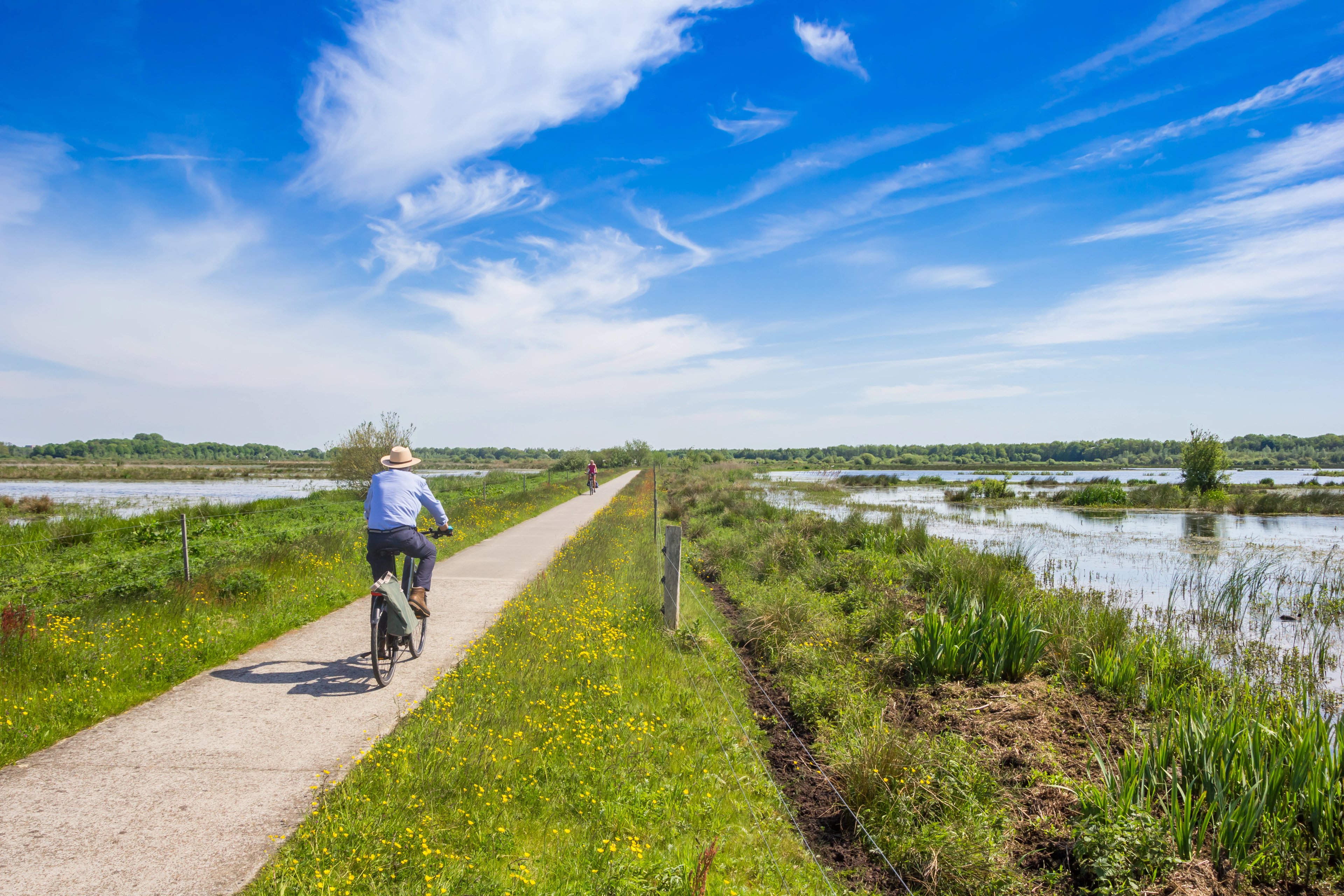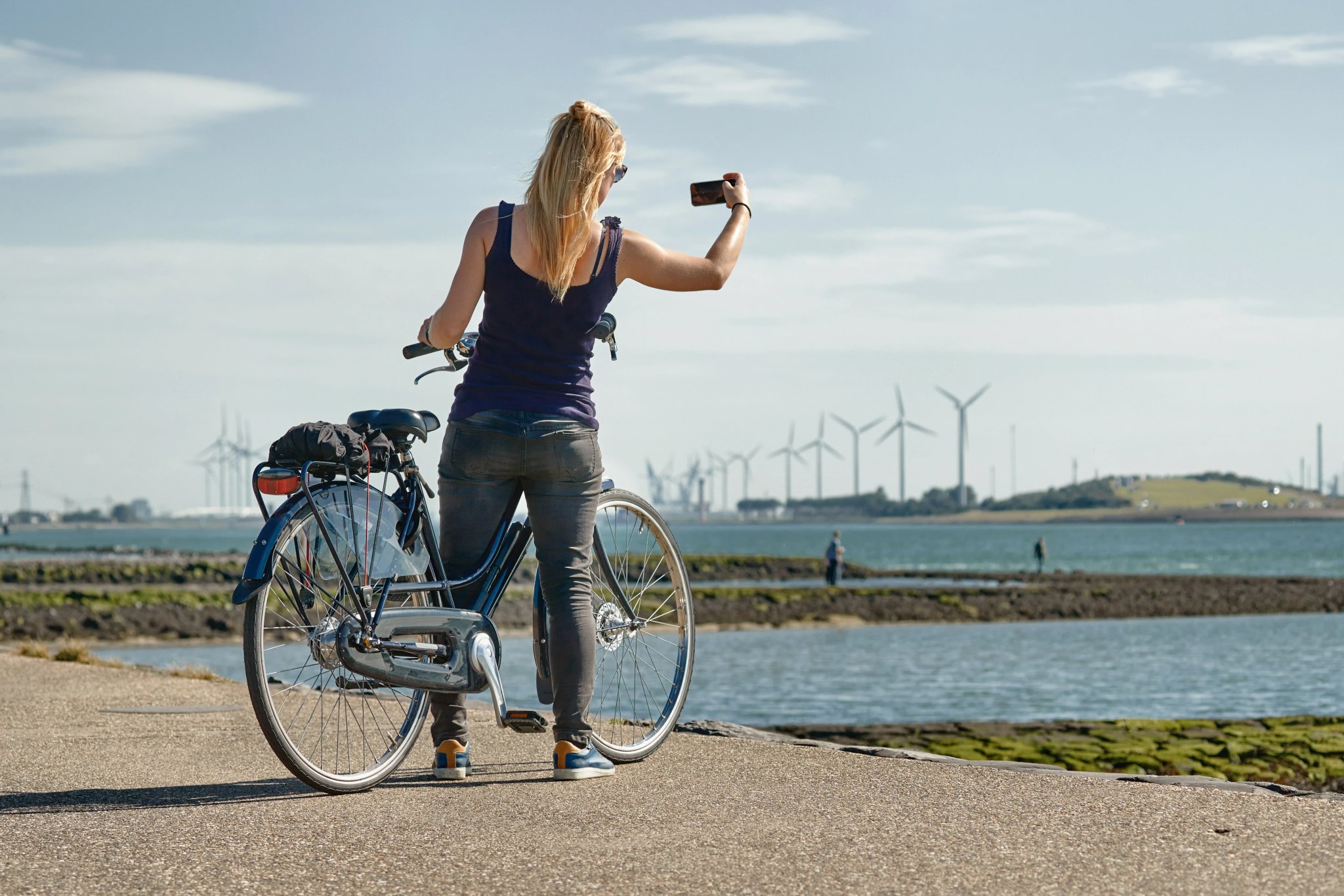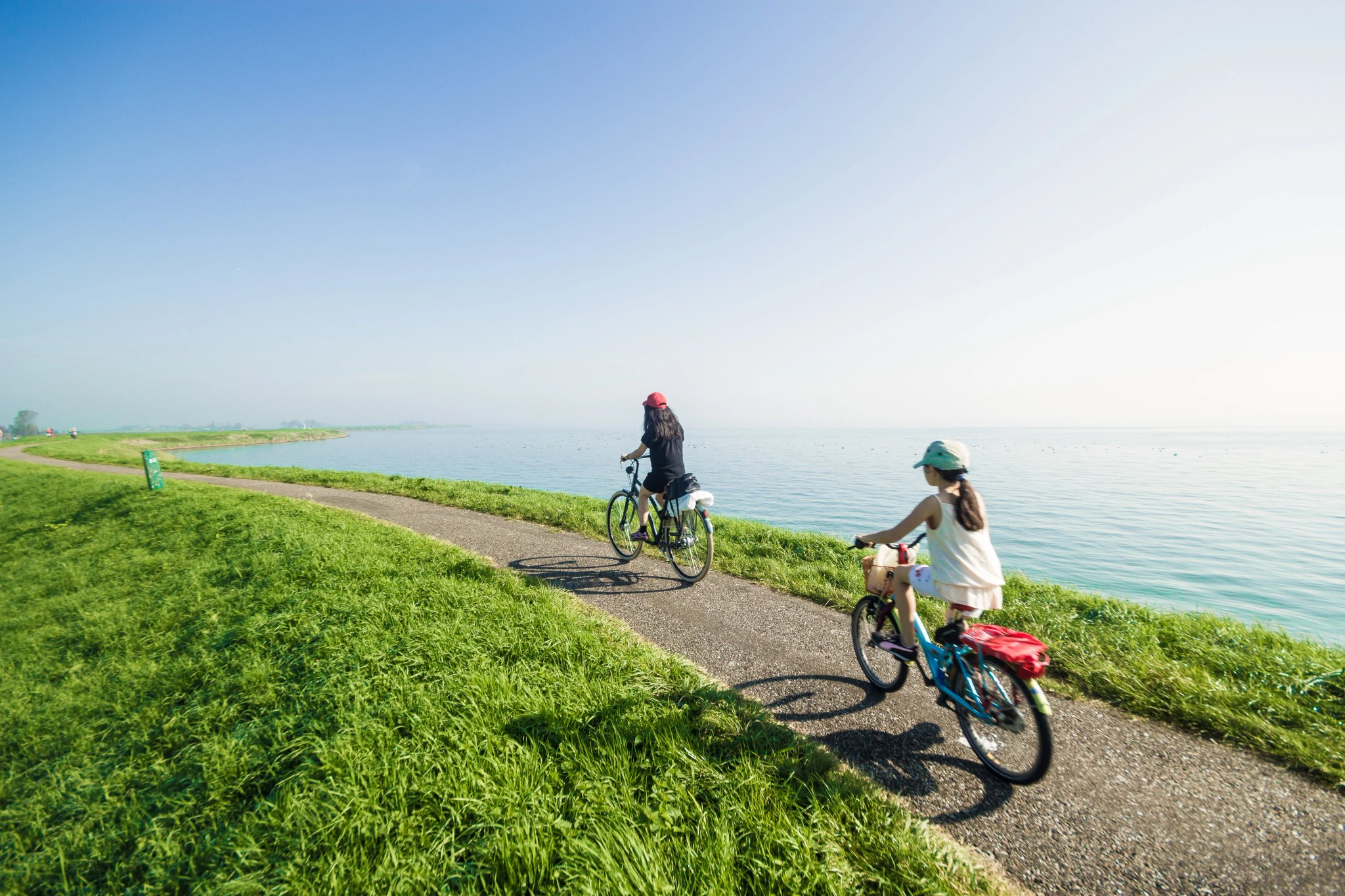Must-See Places on a Cycling Holiday in the Netherlands
Holland is more than tulips and canals — discover top highlights from Amsterdam’s waterways to Kinderdijk’s windmills on an unforgettable cycling trip.

Quick Links
The Netherlands are a compact country filled with historic cities, timeless villages, and landscapes made for cycling. Each stop brings together culture, history, and scenery, turning every ride into a journey through Dutch heritage.
These are the places that every cyclist should have on their list during our cycling tours, based on the regions that they are in.

Top Cycling Destinations of the Netherlands:
1. South Holland – Tulips, Canals, and Cultural Icons
South Holland is one of the Netherlands’ most iconic cycling regions, where flat terrain makes for easy miles and every stage passes a mix of heritage towns, windmills, and flower fields.
From Delft’s canals to the tulip belt and the modern skyline of Rotterdam, this region blends classic Dutch scenery with cultural highlights. It’s the focus of the Highlights of South Holland Tour with some points as parts of the Amsterdam to Bruges tour, making it one of the most accessible introductions to cycling in Holland.

Kinderdijk Windmills
A UNESCO World Heritage Site with 19 windmills set in wide polders. Built in the 18th century to manage water levels, they remain one of the most photographed Dutch landscapes. Cycle paths run directly past the canals, giving close-up views of the mills and surrounding meadows. At sunset, the reflections in the water make this one of Holland’s most unforgettable stops.

Keukenhof Gardens
Known as the “Garden of Europe,” Keukenhof opens from March to May, showcasing more than 7 million tulips and spring flowers. Vast fields outside the park light up in stripes of red, yellow, and purple, creating one of the world’s most spectacular cycling backdrops. Inside, themed gardens and pavilions celebrate Dutch horticulture in style. For many, timing a bike trip to coincide with Keukenhof’s short season is a once-in-a-lifetime experience.

Binnenhof
This medieval complex is the historic heart of Dutch politics and one of Europe’s oldest parliamentary centers still in use. Its Gothic Ridderzaal (Hall of Knights) and cobbled courtyards reflect centuries of decision-making that shaped the Netherlands. Cyclists can easily lock their bikes nearby and explore the site on foot. With its setting beside the Hofvijver lake, the Binnenhof combines history with postcard-perfect views.

Mauritshuis Museum
Famed for its Golden Age masterpieces, this intimate museum houses works like Vermeer’s Girl with a Pearl Earring and Rembrandt’s The Anatomy Lesson of Dr. Nicolaes Tulp. The collection is displayed inside a 17th-century mansion, adding to the charm of the visit. It’s a cultural highlight that pairs easily with a cycling stage through The Hague.

Nieuwe Kerk
This Gothic church dominates Delft’s main square and has served as the Dutch royal burial site since the 16th century. Its 108-meter tower offers sweeping views over Delft’s canals, rooftops, and even as far as Rotterdam on clear days. Inside, ornate tombs and stained-glass windows reveal centuries of national history. Whether climbed for the panorama or visited for its heritage, the church adds depth to a cycling pause in Delft.

Rotterdam
Rebuilt after heavy wartime destruction, Rotterdam showcases a striking contrast to Holland’s historic towns. Bold architecture like the Cube Houses and Erasmus Bridge makes the city a modern design hub, while the vast port remains one of the world’s busiest. Bike paths link its contemporary museums, bustling markets, and riverside promenades seamlessly.

Rijksmuseum
The Netherlands’ national museum, housing masterpieces by Rembrandt, Vermeer, and Van Gogh. Its grand galleries showcase 800 years of Dutch art and history, making it one of Amsterdam’s most important cultural stops. With secure bike parking nearby, it’s an easy detour for cyclists exploring the city.

Anne Frank House
One of Amsterdam’s most visited landmarks, the former hiding place of Anne Frank offers a poignant look into World War II history. Exhibits trace her life and legacy, while the preserved Secret Annex provides an unforgettable experience. Advance ticket booking is essential, especially during peak cycling season.
2. Zeeland – Islands, Dikes, and Sea Views
Zeeland is a province shaped entirely by water, with islands and peninsulas connected by bridges, dikes, and ferries. Cycling here means open skies, salty breezes, and a sense of freedom unique to this coastal region.
Many long-distance routes, including the Amsterdam to Bruges Cycling Tour, pass through Zeeland, where engineering marvels and maritime towns meet.

Delta Works
This vast storm surge barrier is considered one of the greatest feats of modern engineering. Stretching nine kilometers, it protects the low-lying land from the sea while doubling as a cycling route with panoramic ocean views. It’s both a practical necessity and a symbol of the country’s battle with the sea, often named the biggest anti-flood system in the entire world.

Veere Town Hall
Built in the 15th century, this Gothic-style building dominates the small harbor town of Veere. Once a bustling center of trade, today it’s a charming stop where cyclists can rest and explore cobbled streets lined with historic houses. The town hall’s ornate facade and carillon bells add a touch of grandeur to an otherwise quiet village. A pause here feels like cycling back into the Dutch Golden Age.

Middelburg Abbey
The medieval abbey complex in Zeeland’s capital features three distinctive towers, one of which—known as Lange Jan—rises 90 meters above the town. Cyclists can lock up nearby and climb for sweeping views over Middelburg’s rooftops and the surrounding flatlands. Inside, the abbey houses museums that trace the region’s history and art. It’s a reminder that Zeeland is not only about sea defenses but also about centuries of culture.

Westkapelle Lighthouse
This unique lighthouse is built directly into the tower of a former church, making it one of Zeeland’s most unusual landmarks. Its red beacon still guides ships safely along the coast. Cyclists approaching from the dikes see it rising suddenly above the low village rooftops. It’s a compact but striking symbol of how maritime history is woven into daily life here.

Middelburg
Rebuilt after heavy bombing in WWII, Middelburg’s old town has regained much of its former character, with lively market squares, canals, and gabled houses. Today it serves as Zeeland’s cultural hub, offering plenty of cafés and restaurants for a rewarding end-of-day stop. Cycling here mixes heritage with resilience, as the city blends its medieval past with modern energy.
3. Friesland & the IJsselmeer Rim – Water, Wind, and Wide Horizons
Friesland is defined by water: lakes, canals, and the open expanse of the Wadden Sea. Cycling here means riding along long causeways, taking ferries to islands, and pausing in small towns with centuries of seafaring history. The Lake Ijssel Road Cycling Loop captures this region’s essence, offering exposed but unforgettable rides under wide skies.

Woudagemaal Station
A UNESCO World Heritage Site, this steam-driven pumping station from 1919 is still operational today. It represents a milestone in water management, designed to prevent flooding in low-lying Friesland. Visitors can tour the machinery halls and exhibitions, making it a fascinating cultural stop. For cyclists, it’s a reminder of the deep link between engineering and survival in the Netherlands.

Hindeloopen Painted Houses & Museum
The small fishing town of Hindeloopen is famous for its colorful painted woodwork, found in both furniture and building facades. A visit to the local museum explains this centuries-old craft, unique to the area. Narrow streets lined with decorated houses make for a picturesque cycling stop. It’s one of Friesland’s most charming examples of local identity and tradition.

Sneeker Waterpoort
This 17th-century water gate is one of Friesland’s most photographed landmarks. Built as part of Sneek’s defensive walls, it now stands as a symbol of the city’s history. The twin towers rising above the canal create a postcard-perfect scene. Passing through Sneek gives riders a chance to enjoy a lively town center while admiring its historic gateway.

Texel Dunes National Park
Though Texel is often thought of as part of North Holland, its dune landscapes tie closely to Friesland’s seafaring and island culture. The park offers cycling routes through protected dunes, wetlands, and birdwatching reserves. Ferries connect the island easily, making it a natural extension to rides along the IJsselmeer. Riders can expect wide horizons, sea breezes, and encounters with unique wildlife.

Leeuwarden
Friesland’s capital blends old and new, with canals, historic buildings, and a leaning tower known as the Oldehove. The city also has a lively cultural scene, hosting festivals and exhibitions that celebrate the province’s heritage. For cyclists, it’s a convenient and rewarding base before venturing into Friesland’s lake country. Leeuwarden brings together Friesland’s proud history and modern energy in one compact hub.
4. Limburg – Hills, Vineyards, and Classic Cycling Terrain
Limburg is unlike the rest of the Netherlands: rolling hills replace flat polders, vineyards cover slopes, and legendary climbs define the cycling culture. This is the province of the Amstel Gold Race, where every corner seems to echo with cycling history. It’s a natural extension for riders who want elevation after exploring Holland’s flatter regions.

Valkenburg Castle Ruins
Perched above the town of Valkenburg, these ruins are the only hilltop castle remains in the Netherlands. Once a medieval stronghold, the fortress was destroyed in the 17th century but still dominates the town’s skyline. Walking or cycling up to the ruins gives both history and views across the Limburg hills. The site ties seamlessly into Valkenburg’s reputation as a hub for Dutch cycling and culture.

Caves of Fort Sint Peter
This vast network of limestone tunnels runs beneath the St. Pietersberg Fort outside Maastricht. Originally quarries, the caves later became wartime shelters and even a hiding place for art, including Rembrandt’s Night Watch. Guided tours reveal their layered history and eerie underground passages. For cyclists, it’s a fascinating diversion from the roads above, connecting history with the landscape.

Basilica of Our Lady
Dating back to the 11th century, this Romanesque church is one of the oldest and most revered in the Netherlands. Its heavy stone walls and candlelit interiors create a sense of timelessness. The treasury holds religious relics and treasures tied to Maastricht’s role as a pilgrimage site. Located right in the old town, it’s a rewarding cultural stop between rides.

Cauberg Hill
The most famous climb in Dutch cycling, the Cauberg has been central to the Amstel Gold Race for decades. Though short at just over a kilometer, its gradients of 8–12% test even seasoned riders. Amateurs can tackle it themselves, riding in the wheel tracks of legends. The summit area buzzes with cycling cafés and a proud sense of local racing tradition.

Hoensbroek Castle
One of the largest and best-preserved castles in the country, Hoensbroek spans centuries of Dutch history. Its moated towers, furnished halls, and interactive exhibits make it one of the most family-friendly castles to visit. Cycling up to the entrance feels like entering a storybook world. The castle’s scale and atmosphere set it apart from the many smaller manor houses scattered through Limburg.

Maastricht
The southernmost of Dutch cities, Maastricht combines Roman history, medieval streets, and a lively café culture. Its cobblestone lanes, riverside quays, and international character make it a highlight for both culture and cuisine. The city is also a cycling hub, hosting events and offering easy access to the surrounding hills. Maastricht ties together the best of Limburg: history, heritage, and hills.
Ride Through Holland’s Heritage
From the windmill-studded polders of South Holland to the cobbled climbs of Limburg, cycling in the Netherlands brings a mix of scenery, history, and everyday culture. Each region adds its own flavor—UNESCO landscapes, engineering marvels, medieval towns, and vibrant cities—woven together by the country’s unmatched cycling network.

Browse our Holland bike tours for curated itineraries, or reach out and let us help you find the route that fits your riding style best.
We can also tailor any tour to your wishes and include highlights such as Maastricht, Valkenburg, or other places from our list if you’d like them added to your journey.

Hassle-Free
We handle itineraries, accommodations, and anything else you prefer not to deal with, so you can enjoy a carefree holiday.

Completely Customizable
Flexibility is our middle name — whether you want more or less, or just beyond ordinary, we’ll make it happen.

Book with confidence
We are a financially protected company, fully bonded and insured, keeping your money safe and allowing you to travel with confidence.

Unbeatable support
Our 24/7 customer support is where we show our passion, bringing you a better experience by making your well-being our number one priority.
.jpg&w=3840&q=75)
